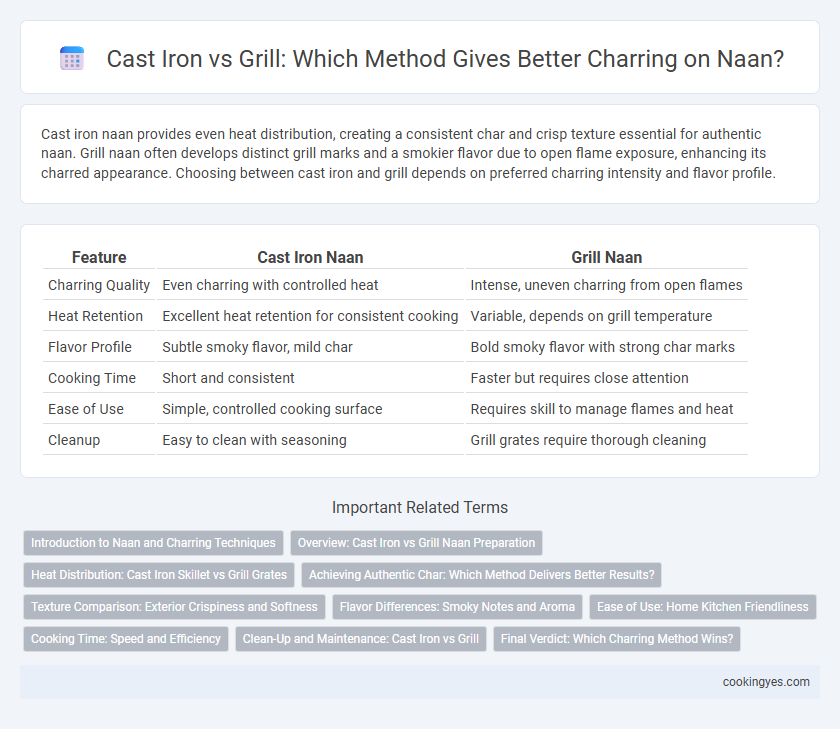Cast iron naan provides even heat distribution, creating a consistent char and crisp texture essential for authentic naan. Grill naan often develops distinct grill marks and a smokier flavor due to open flame exposure, enhancing its charred appearance. Choosing between cast iron and grill depends on preferred charring intensity and flavor profile.
Table of Comparison
| Feature | Cast Iron Naan | Grill Naan |
|---|---|---|
| Charring Quality | Even charring with controlled heat | Intense, uneven charring from open flames |
| Heat Retention | Excellent heat retention for consistent cooking | Variable, depends on grill temperature |
| Flavor Profile | Subtle smoky flavor, mild char | Bold smoky flavor with strong char marks |
| Cooking Time | Short and consistent | Faster but requires close attention |
| Ease of Use | Simple, controlled cooking surface | Requires skill to manage flames and heat |
| Cleanup | Easy to clean with seasoning | Grill grates require thorough cleaning |
Introduction to Naan and Charring Techniques
Naan, a traditional Indian flatbread, achieves its signature texture and flavor through charring techniques that enhance its aromatic profile. Cast iron naan offers even heat distribution for controlled charring, producing a uniform crispness with a slight smoky flavor. Grill naan exposes the bread directly to open flames, creating intense char marks and a distinct smoky taste that highlights the bread's leavened, airy texture.
Overview: Cast Iron vs Grill Naan Preparation
Cast iron naan offers even heat distribution, creating a perfectly charred, crispy exterior with a soft, chewy interior due to its consistent high temperature retention. Grill naan benefits from direct flame exposure, imparting a smoky flavor and visible char marks while requiring careful attention to prevent burning. Both methods yield distinctive textures and flavors, with cast iron providing uniform cooking and grill offering authentic smoky charring.
Heat Distribution: Cast Iron Skillet vs Grill Grates
Cast iron skillets provide superior heat retention and even heat distribution, creating a consistent cooking surface for uniformly charring naan. Grill grates expose naan directly to open flame and hot spots, resulting in uneven charring and variable texture. The smooth, heavy cast iron surface also prevents sticking and allows precise control over browning compared to the more dispersed heat of grill grates.
Achieving Authentic Char: Which Method Delivers Better Results?
Cast iron naan achieves authentic char through even heat distribution, creating characteristic bubble blisters and a smoky crust similar to traditional tandoor ovens. Grill naan offers direct flame exposure, producing distinctive grill marks and a charred flavor but may result in uneven cooking due to variable heat zones. For consistent char and texture closely replicating classic tandoor naan, cast iron cooking is generally preferred.
Texture Comparison: Exterior Crispiness and Softness
Cast iron naan delivers superior exterior crispiness due to its consistent high heat retention, creating a perfectly charred crust while maintaining a soft, airy interior. Grill naan achieves authentic smoky char marks and a slightly chewier texture but may lack the even crispiness found in cast iron preparation. The cast iron method balances a crisp outer layer with tender softness inside, whereas grill naan emphasizes a rustic, smoky flavor with less uniform texture contrast.
Flavor Differences: Smoky Notes and Aroma
Cast iron naan develops a rich, smoky aroma due to the even heat retention and slight charring that enhances the Maillard reaction on the dough's surface. Grill naan acquires distinct smoky notes from direct exposure to open flames, imparting an authentic charred flavor with subtle hints of wood smoke. Both methods offer unique flavor profiles: cast iron provides a deeper caramelized taste, while grill grilling infuses a vibrant smokiness that heightens the naan's overall aroma.
Ease of Use: Home Kitchen Friendliness
Cast iron naan offers consistent heat distribution and requires minimal equipment, making it highly user-friendly for home kitchens focused on achieving even charring. Grill naan benefits from the smoky flavor imparted by open flames but demands more skill and specialized outdoor equipment, which may limit ease of use indoors. For home cooks seeking convenience and reliable charring, cast iron pans provide a practical and accessible option.
Cooking Time: Speed and Efficiency
Cast iron naan cooks faster than grill naan due to the pan's excellent heat retention and even surface, providing consistent high temperatures that quickly char the dough. Grill naan requires longer cooking time as it relies on direct flame and less uniform heat, which may cause uneven charring and slower cooking. Overall, cast iron offers superior speed and efficiency for achieving the ideal char on naan bread.
Clean-Up and Maintenance: Cast Iron vs Grill
Cast iron naan cookware offers easier clean-up due to its smooth surface and ability to be seasoned, preventing food from sticking and reducing residue build-up. Grill naan pans require more upkeep as grill grates accumulate charred bits and grease, demanding thorough scrubbing and more maintenance to avoid rust. Maintaining cast iron involves periodic seasoning and drying, while grills need regular deep cleaning and protective covers to ensure longevity.
Final Verdict: Which Charring Method Wins?
Cast iron naan delivers an even, intense charring due to its consistent high heat retention, creating a crispy exterior with well-defined char marks. Grill naan benefits from open flame exposure, imparting smoky flavors and unpredictable char patterns that enhance the naan's texture and aroma. For consistent and controlled charring with a rich crust, cast iron naan is preferred, while grill naan excels in adding authentic smoky notes and rustic appeal.
Cast iron naan vs Grill naan for charring Infographic

 cookingyes.com
cookingyes.com